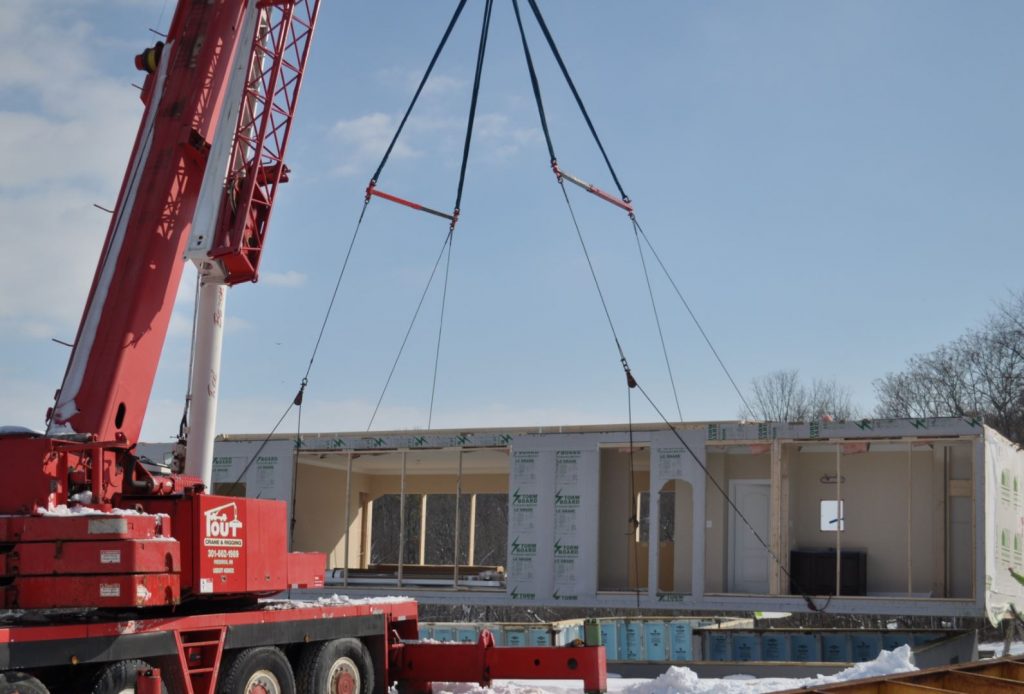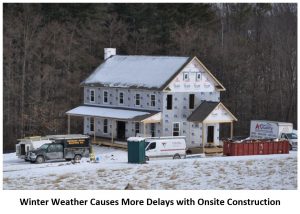Does Winter Stop Home Construction?


The short answer is NO… but… America is divided into many climate zones and weather and temperature are very different by region of the country. In the southern states, homes are built all year. In the northern zones, you have a mix. In the upper northwest, influenced by warm coastal temperatures, construction can easily take place year round. Builders in the rest of the northern states have typically felt like construction outdoors came to a halt during the harshest winter months and you focused on indoor construction until spring. With today’s building technologies and products, you don’t have to let the weather dictate when you construct your new home.
When Weather Impacts a Home Site
 Winter can create obstacles for home construction. But almost everyone that works on a home site can work in all but the worst conditions. With outdoor construction, work crews tend to not work as fast in the cold, rain, snow and the mud. The extra clothing needed and sloppy job sites slow them down. The short days of winter can also impact the amount of work done. Colder temperatures require homes to be heated adding extra expenses and delays of heaters aren’t available. Heat is needed to complete drywall, install flooring, protect water pipes, and to finalize interior finishes. In colder weather, the heat-activated adhesive on shingles won’t set so shingles are subject to high wind events.
Winter can create obstacles for home construction. But almost everyone that works on a home site can work in all but the worst conditions. With outdoor construction, work crews tend to not work as fast in the cold, rain, snow and the mud. The extra clothing needed and sloppy job sites slow them down. The short days of winter can also impact the amount of work done. Colder temperatures require homes to be heated adding extra expenses and delays of heaters aren’t available. Heat is needed to complete drywall, install flooring, protect water pipes, and to finalize interior finishes. In colder weather, the heat-activated adhesive on shingles won’t set so shingles are subject to high wind events.
With foundations, additives such as calcium chloride can be added to the concrete mix to accelerate the curing process in colder weather. In comparison, concrete with additives is not significantly different in strength as concrete without additives when fully cured. Many custom home builders have tended to avoid additives in concrete where possible. But concrete foundation walls with additives in the mixture must meet the required building code. In some cases, temperatures can be so cold that pouring concrete isn’t feasible. However, in most cases, insulating freshly poured concrete floors with concrete blankets or straw can protect concrete during a cold snap.
RELATED: Modular Homes Make Your Family Safer During a Storm
When building onsite, once the home is under roof and windows and doors are installed, work can continue relatively unencumbered from outside weather and temperatures. But there can be additional expenses to winter construction because of delays and extra fuel or electricity for heat. However, as is typical with onsite construction, the process is linear. This means that you can’t start building the home until the foundation is completed. What this also means is that your home and your budget is exposed to more risk because the complete construction process takes place outdoors. This makes the complete process susceptible to potential winter weather delays.
Modular Construction is the Modern Weather Beater!
With outdoor construction, weather delays can add to the cost of construction. While providing heat to complete homes in all climates can add to the cost of construction, modular construction means delays and costs can be mitigated. Most of the drywall and flooring are completed in the factory. The timeframe to complete a home onsite is compressed meaning heating a home is only necessary for weeks, not months. This helps keep any additional costs to build in winter very low. But remember, what many home buyers fail to take into account is that suppliers tend to implement price increases in late spring. Many of these increases can be significant, in the 5-7% range. These price increases can have a significant impact on a home’s price. In many cases, price increases can easily exceed any increased costs when building in the winter.
Combining modular construction with winter building just makes sense. By taking weather out of the equation, homebuyers have a much better chance of completing their homes sooner and beating those late spring price increases. Modular construction takes place indoors. It is also taking place at the exact same time as the site excavation and foundation construction is taking place. There are no delays due to snow or extreme cold. Work doesn’t slow down because workers are cold or have to wear additional protective clothing. Finishes can be completed without the cost of temporary heat. Snow isn’t laying and melting on floors or in the wall cavities of your new home.
A modular home is built indoors in environmentally controlled conditions. It is always summer in the factory. You can be assured that the same high quality is achieved year round when constructing your home. In fact, even the same cost efficiencies of modular construction apply year round, there are no penalties for the modular portion of your new home’s construction when building in winter. Don’t let winter dictate when you can begin building your new custom home. Modular makes it better when building in the winter.
The post Does Winter Stop Home Construction? appeared first on Impresa Modular.




